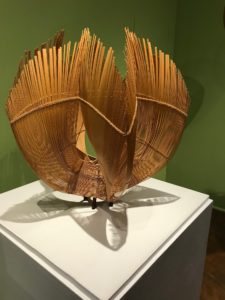In a city like Los Angeles, where there’s always some fresh starburst to occlude the starburst (or firestorm) that ignited only moments before, it’s easy to lose track of the treasures strewn in our path that will endure long after the firestorms have died down to ashes. It could be an event, a theatrical or media phenomenon, a news story or just the latest internet meme that seems to rearrange the talking points of our conversations for the next week or month—which, with the exception of the occasional ‘blockbuster’, is not the way we talk about most museum shows. That applies particularly to smaller museum shows—and there have been a few this past summer in Los Angeles that, amid the stream of group shows and events popping up all over the city, have receded amid the fireworks when they should be celebrated and savored.
Holland Cotter wrote about a couple of these exhibitions (along with the Hammer Museum’s Made in L.A. 2018) in The New York Times last week, one of which was the UCLA Fowler Museum’s Striking Iron: The Art of African Blacksmiths—which is one such treasure that should not be overlooked.

Akio Hizume, “Fibonacci Tunnel” (2008) on-site installation, Craft & Folk Art Museum, Los Angeles
It’s somewhat more surprising when an exhibition at a museum with manifestly greater visibility slips under the radar; but that can happen in Los Angeles (even if on almost any given day you might be driving past it). The Craft and Folk Art Museum can occasionally seem eclipsed by its monumental neighboring museum across the street. But over the past summer, I’ve felt its gravitational pull whether I was walking or driving past it. Some of that ‘pull’ might be credited to Katherine Gray’s gorgeous window installation for her own show (As Clear as the Experience) in CAFAM’s first level gallery space, which never fails to draw me into its rainbow shimmer. But what really draws me back is an almost vortical pull that probably owes something to Akio Hizume’s Fibonacci Tunnel—possibly the site-specific centerpiece of this show—a tunnel/bridge construction built entirely of moso bamboo poles, stakes and fastenings. (This is a two-ton plus structure that can roll, but is in a fixed stationary position here in the museum gallery space. Visitors can actually walk through it.) Remarkably that’s not where my thoughts go first, which is more likely a breathtaking dance of spiral geometries by Honda Shōryū, titled appropriately enough, Dance (2000), an intricate complex of twisted spiral and parabolic volumes woven together in a delicately entwined openwork netting of bamboo that seems to turn and fold in upon itself—an architecture of perpetual motion.
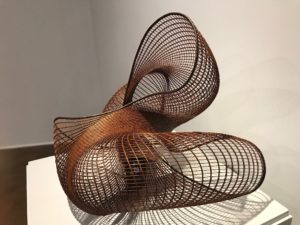
Honda Shōryū, “Dance,” 2000
I cannot stop thinking about this sculpture—which is simply one work in an exhibition of many almost equally breathtaking masterpieces. The exhibition is Bamboo; and I wish it would never close. Taken as a whole the show might itself be viewed as a masterpiece of fusion: of geometry and poetry, of the organic and the abstract, of the architectural and the natural-ephemeral. To consider that last ‘fusion’ for a moment, not far from Shōryū’s masterpiece, is what looks like a spiraling flat ribbon of woven bamboo and rattan, descending into a concavity that might serve as a basket, but whips outward in an undulant double spiral that seems about to fly away. This is Honma Hideaki’s Sign of Wind IV. Hideaki’s art is equally alive to the music in the wind. His Wind Rhyme (1998) is a double-fold of six bamboo horizontals wrapped around a central vessel of fine plaited rattan, traversed perpendicularly by two bamboo verticals towards the right side of the construction wrapping and seemingly binding the central organ-like mass that might conceivably be a kind of pipe organ or flute or panpipes. The poetry here is clearly material and abstract; but at the same time it evokes larger Japanese poetic traditions that extend back as far the 14th century. (I can’t help thinking of the kinds of elaborately folded packages—some more than simply paper, and frequently holding letters and messages composed in poetry—described by Sei Shōnagon in her famous Pillow Book.)
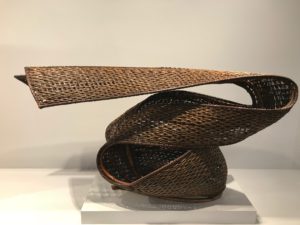
Honma Hideaki, “Sign of Wind IV,” 2002
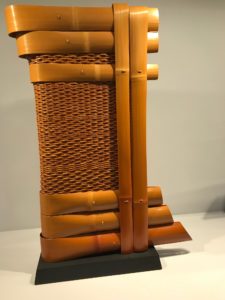
Honma Hideaki, “Wind Rhyme,” 1998
For a show both as compact and distinctly abstract as this one, Bamboo has a remarkable reach. The most mathematically abstract configurations here may be touched by ceremony, while the most ceremonially evocative (or alternatively, straightforwardly utilitarian) objects elegantly play out their mathematics. The nexus between nature and the mathematical or abstract is beautifully articulated in this show. The rhythm, musicality, and poetics of material form—and its natural organic sources and inspirations—are celebrated in every work exhibited here.
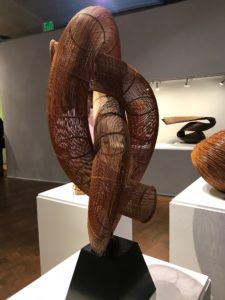
Fujitsuka Shōsei, “Winding,” 1983
I don’t think it’s entirely accidental that Japanese basketry and bamboo weaving and craft traditions, imported into Japan, like so many aspects of Japanese culture, from China, eventually eclipsed its Chinese forebears. Although Chinese models continued to be imported into and admired in Japan well into the 18th century, Japanese arts and crafts had already by the 16th century embraced a more nature-bound, wabi-sabi aesthetic. This is a legacy that reflects an acute appreciation and sense of connection with nature.

Iizuka Rokansai, “Kake Hanaire,” 1945

Nakamuri Tomonora, “Sprite,” 2013

Kawashima Higeo, “Cosmic Ring,” 2001
The architecture (and mathematics) of the sculptures extends from the earthbound (Fibonacci, etc.) to the cosmic with an array of two- and three-dimensional themes and variations in between—from a sheer waterfall of bamboo (that one might also imagine as a prepared musical instrument) (Higashi Takesonosai) or a hanging flower basket fashioned as a simple envelope cut from a bamboo sheet (Iizuka Rokansai); to a lantern configuration of caned and plaited interlocking hexagonal screens that might be a shadow warrior’s armour (Nakamura Tomonori); to both circular and spherical tori (and more subtle topological mutations), e.g., Kawashima Shigeo’s Cosmic Ring (2001); to what might be the long bamboo dress of eternity—a shroud or gown woven from a single piece of bamboo (Nagakura Kenichi). (It sounds breathtaking because it is breathtaking.)

Nagakura Kenichi, “Human Being,” 2000

Shōnō Tokuzō, “Flower Bud,” 2003
Flowers are a constant inspiration here, both in terms of the ostensible purpose of some of these objects (though it’s clear that most of these have transcended this functional aspect), and their subtle geometries and architecture. Spirals and the notion of a continuous unbroken curve return in many iterations. A “Flower arranging basket” (1956) by Maeda Chikubōsai, II might be compared to a flattened Möbius strip—although the artist makes no attempt to hide the beautifully crafted joins and trims—challenging the ‘florist’ who might attempt to use it for that purpose. Or consider the Flower Bud (2003)—it might be a vessel, or it might be an architecture for a space or structure we have yet to imagine, or an abstraction of the chrysanthemum that presumably inspired it—by Shōnō Tokuzō. Here a network of interlocking parabolae are enveloped by a larger spheric framework with a continuous sine curve suspending spandrels joined like a star aster at the very bottom of the vessel. (It could be a rollercoaster that in reverse might be reimagined as a dome lifted above fan vaulting.)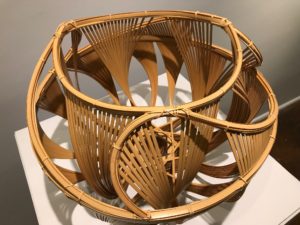
 It was perhaps inevitable that this floral architecture might be re-engineered in concrete terms—which brings us back to Akio Hizume’s Fibonacci Tunnel. The Fibonacci sequence has its natural analogue in many flowers, most famously the sunflower spiral (e.g., opposing spirals of 55 in one direction and 89 in the other, etc. ; similar spiral ratios are observable in pine cones). Obviously the tunnel is not exactly a Fibonacci spiral (it doesn’t get larger or smaller), but canting each element at the phyllotaxic limit of that typical floral circumference (the ‘Golden mean’ of sequential Fibonacci numbers is approximately 1.618034) yields the consistently proportioned and more or less stable weight-bearing structure Hizume has constructed here. (Hizume has also constructed a Star Cage suspended outside the Museum.)
It was perhaps inevitable that this floral architecture might be re-engineered in concrete terms—which brings us back to Akio Hizume’s Fibonacci Tunnel. The Fibonacci sequence has its natural analogue in many flowers, most famously the sunflower spiral (e.g., opposing spirals of 55 in one direction and 89 in the other, etc. ; similar spiral ratios are observable in pine cones). Obviously the tunnel is not exactly a Fibonacci spiral (it doesn’t get larger or smaller), but canting each element at the phyllotaxic limit of that typical floral circumference (the ‘Golden mean’ of sequential Fibonacci numbers is approximately 1.618034) yields the consistently proportioned and more or less stable weight-bearing structure Hizume has constructed here. (Hizume has also constructed a Star Cage suspended outside the Museum.)
It was impossible to escape the paradox of material durability and vulnerability embodied by Yamaguchi Ryuun’s Fire (2006)—as wildfires raging throughout California amplified the climate disaster and environmental degradation the planet is contending with. But there was also something of the mythic phoenix in it, evoking an eternity of cosmic rebirth. Optimism is in short supply these days, but the music, mathematics and poetry of this sublime show offers something to reinspire us for the struggles ahead.